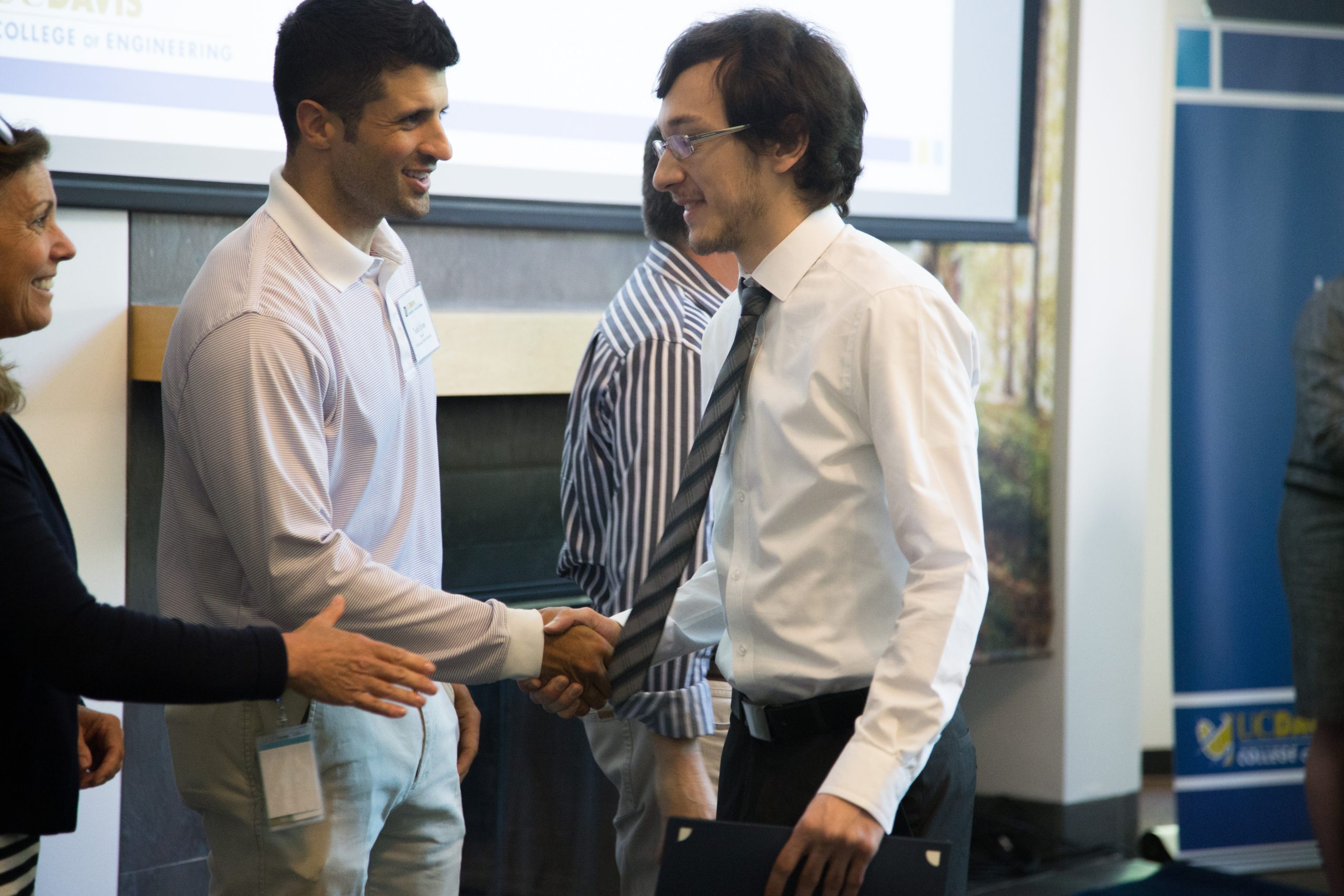Chapter 2: Interview With a Small Talk Expert
Before You Read
Look at the picture.

- Where are they?
- What are they doing?
- What are they saying?
Read

Teaching Point
Reading a script is different than reading a story. First, scripts have lines, not paragraphs. Secondly, when you read a script, you do not read every word. For example, the first word in a new line usually informs the reader of who is talking. Do not read their names. The names inform people when to speak. Finally, a script may give directions for acting. The directions are usually in parentheses (…) and in italics. For instance, one line in this script says the interviewer should laugh.
As you listen, notice the difference between the written script and the audio recording. The audio is reading the text as a script.
This is an interview with James Smalley. He is an expert on small talk. He talks about the responsibilities of his job. He gives advice for making small talk.
Interviewer: Hello everyone, and welcome back to our show! We are here talking with our guest, James Smalley. He is an expert on making small talk. Thank you, James, for joining us today.
James: It’s nice to be here. Thank you for inviting me.
Interviewer: Yes, well, people in your career are interesting to interview! Let’s skip the small talk and get right to our discussion! Ha! Did you like that?
James (laughs): Yes, you are very funny! What is your first question?
Interviewer: Could you tell us what you do in your job?
James: Sure. A small talk expert knows the skills people need to have light conversations. My job is to teach people how to start and continue interesting dialogues in different situations. I help people talk with others quickly and comfortably.

Interviewer: That sounds quite interesting. What would you say is the key to making successful small talk?
James: The key is to be interested in the other person. Ask open-ended questions such as “How do you like this weather?” or “Where is a good place to eat around here?” Those questions encourage people to talk. It’s also important to be a good listener. Small talk isn’t just about one person talking; it’s about listening, too.

Interviewer: Can you give our listeners some advice? How can we make small talk easy?
James: Sure. Talk about safe topics like the weather, hobbies, or a recent event. And remember, practice makes perfect. The more you talk to people, the more comfortable you’ll become.
Interviewer: How do you handle situations where the conversation is not enjoyable?
James: Be flexible. If something isn’t interesting, change it. Plan to talk about a few different topics. And don’t be afraid of a little silence; sometimes it gives the other person a chance to think and contribute more to the conversation.

Interviewer: Lastly, any words of wisdom for our audience?
James: Yes. Small talk is an art that anyone can master with a bit of patience and practice. It opens doors to new relationships and opportunities. So, take a deep breath, smile, and just start talking. The rest will follow naturally.
Interviewer: Thank you for sharing your ideas with us today.
James: It’s been my pleasure. Happy chatting!
Vocabulary
Contribute
Event
Expert
Flexible
Job
Plan
Skill
Successful
Topic
After You Read
- Do you like to talk to new people? Why or why not?
- Did James give good advice? Why or why not?
- What topic do you know a lot about? Give advice about it.
Media Attributions
- “Female late night TV show host behind a desk on a stage with a microphone beside a male guest sitting on a sofa next to the desk” prompt, by Adobe Firefly, 26 Aug. 2024, was artificially generated using Adobe Firefly and is, therefore, shared under CC0 1.0.
- “Hand holding a marker, writing on a whiteboard with weather, hobbies, sports, pets, neighbourhood, home country written on the board and pictures of weather, sports, hobbies, pets, and a home. Cross out the word ‘sports'” prompt, by Adobe Firefly, 22 Aug. 2024, was artificially generated using Adobe Firefly and is, therefore, shared under CC0 1.0. / Adaptations: removed items from the image and added marker text.
- SP15_ScholarshipAwards_KL-5249 by UC Davis College of Engineering is licensed under CC BY 2.0.
- ISC Integration Party Spring 2012 by Jirka Matousek is licensed under CC BY 2.0.
References
Adobe. (2024). Adobe Firefly [Image generator].
Arizona State University. (2024). EdPlus Voiceover Generator [Voiceover audio generator].
Microsoft. (2023). Copilot [Large language model].
Artificial Intelligence Disclosure
- Microsoft Copilot was used as a brainstorming tool for this chapter.
- Adobe Firefly was used to generate images, where indicated.
- The Arizona State University EdPlus Voiceover Generator was used to create the audio recording of the reading. Adaptations include modification of speed and/or timing, and comping of output takes.
Job - view the definition in the Collins Dictionary [New Tab]
Expert - view the definition in the Collins Dictionary [New Tab]
Skill - view the definition in the Collins Dictionary [New Tab]
Successful - view the definition in the Collins Dictionary [New Tab]
Topic - view the definition in the Collins Dictionary [New Tab]
Event - view the definition in the Collins Dictionary [New Tab]
Flexible - view the definition in the Collins Dictionary [New Tab]
Plan - view the definition in the Collins Dictionary [New Tab]
Contribute - view the definition in the Collins Dictionary [New Tab]

